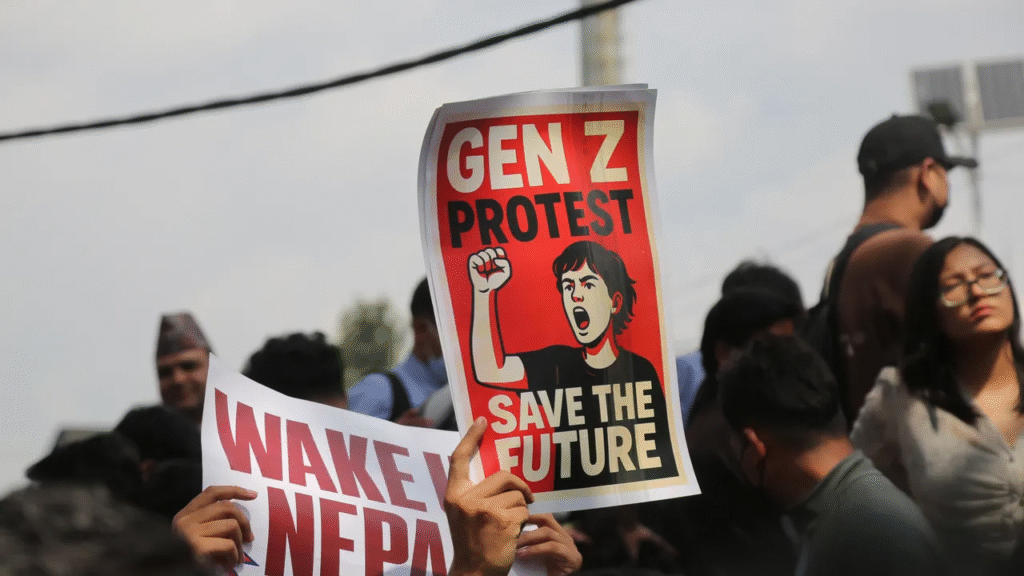
In the first two weeks of September 2025, the streets of Kathmandu and other Nepali cities turned into arenas of defiance. Triggered by a sweeping ban on social media platforms, WhatsApp, YouTube, X, among others, tens of thousands of young Nepalis took to the streets. What began as a reaction to a clampdown on digital freedoms quickly spiraled into a generational revolt against corruption, opacity, and elite capture of politics in which, ironically many Maoist former guerilla leaders play major roles. Nineteen lives were lost, and several official buildings were burned or defaced by the rioters, but the protests forced the government to reverse the ban. In the aftermath, Nepal witnessed another symbolic milestone: the appointment of its first woman Prime Minister, a shift that underlined the generational and societal churn underway (although the 73-year-old Sushila Karki can hardly be seen as a figure attuned to the rebellious spirit of Gen-Z).
This is not just a Nepali story. It is a window into the political battles of the future where youth movements, empowered by technology, not ideology, and guided by the desire for transparency, demand a new social contract, although vandalism and criminality were also at play in the brutal beatings and murders of various politicians by enraged mobs.
The Rise of the Digital-Native Citizen
Nepal is among the youngest nations in Asia: nearly 70 percent of its people are under 35. Unlike previous generations, Nepali Gen Z has grown up in a digital ecosystem. Social media is not merely entertainment; it is identity, community, and political space. When the government attempted to regulate or ban platforms, it attacked the very medium through which young Nepalis define themselves and organise.
What sets this generation apart is not just its demographic weight; it is also technological empowerment. AI-enabled tools, global connectivity, and access to information mean that secrecy, the traditional lubricant of politics, is no longer tenable. In an age where “nothing remains hidden,” every misstep of the state is amplified, archived, and challenged.
AI, Transparency, and the Politics of Trust
Against this backdrop, Nepal rolled out its National Artificial Intelligence Policy 2025. The policy is ambitious: it envisions AI in governance, healthcare, education, and innovation, while stressing ethical use, accountability, and safeguards. Yet, for Gen Z, AI is not an abstract framework. It is a double-edged sword.
Used responsibly, AI could usher in radical transparency, real-time monitoring of government spending, predictive models to prevent corruption, data-driven governance that reduces arbitrariness and individual power. However, the same tools could be weaponised for increasing State surveillance, manipulation of opinions, and censorship. The protests in Kathmandu revealed precisely this tension: the state’s instinct to control society versus the youth’s demand for open digital commons.
The battle for AI’s soul is not so much about technology, it is about trust. And for democracies, trust is the currency they can no longer afford to squander.
From Patronage to Participation
For decades, Nepal’s politics has been caught in the churn of patronage, factionalism, and personalised leadership. Political parties function more as power-brokering networks than as ideological vehicles. Gen Z is rejecting this model. Their movements are leaderless yet loud, decentralised yet impactful. They do not seek to replace one strongman with another; they demand a system where institutions, not personalities, hold power accountable.
This has profound implications for democracy. If parties and institutions fail to reform, youth may increasingly use alternative channels such as online forums, protest networks, even parallel civic structures that are already in existence. The risk is not only democratic drift but democratic bypass. the formal state could become irrelevant to citizens who find representation elsewhere, as is becoming the case in many old democracies where less and less people vote and pay attention to their nominal national leaders.
Nepal as a Microcosm of Global Trends
Nepal is not an outlier. From Hong Kong’s Umbrella Movement to Chile’s constitutional protests, from the climate activist marches in Europe to the pro-democracy push in Africa, Gen Z movements carry a common DNA. They are digital-first, transnational in inspiration, and intolerant of corruption or opacity., though rarely able to propose viable alternative models of governance,
Three global lessons emerge from Nepal’s recent upheaval:
- Digital-Native Democracies: Politics is increasingly mediated through platforms, data, and networks. Parties that fail to adapt risk obsolescence.
- Accountability by Default: Leaks, citizen journalism, and AI-driven transparency tools mean misgovernance is rapidly exposed. The old playbook of secrecy is rapidly exposed.
- Institutional Strain: Traditional parliaments, parties, and bureaucracies are ill-suited to the pace of digital politics. The gap between slow institutions and fast-moving citizens usually influenced by NGOs, foreign and domestic, widens by the day.
Possible Futures for Nepal—and Beyond
The trajectory of Nepal’s Gen Z movement holds three possible scenarios, each of which carries lessons for other democracies in flux.
- Best Case: Gen Z catalyses democratic renewal. Institutions embrace transparency, political financing is cleaned up, digital governance reforms take root, and AI is deployed for accountability rather than surveillance. Nepal emerges as a model for youth-driven democratic resilience.
- Drift: Cosmetic reforms pacify protests but leave structural corruption intact. Youth movements fragment into subcultures, and politics continues as usual. Democracy survives but without popular legitimacy.
- Worst Case: Elites double down on repression. Social media crackdowns intensify, AI is weaponised for control, and disillusioned youth radicalize. The system is destabilised, and democracy decays into populist authoritarianism.
The choice lies not with Gen Z alone but with institutions willing, or unwilling, to adapt.
The Future of Democracy Will Be Digital
Nepal’s story is a cautionary tale for democracies worldwide. The new era of politics is not defined by party manifestos, it is shaped by hashtags, digital campaigns, and AI-enabled transparency. Gen Z is not waiting for permission; they are rewriting the rules of engagement.
For governments, the message is simple: embrace transparency, or be swept aside. For societies, the challenge is to channel the raw energy of youth into constructive institutional reform rather than episodic street uprisings. For democracies, the future is not just defined by ballots and parliaments, it is in the digital commons that legitimacy is forged but also rapidly lost.
In Kathmandu this September, Gen Z showed that even in a small Himalayan State, the tide of history is shifting. The message reverberates far beyond Nepal: the democratic process must evolve for the digital age, or it will wither into irrelevance.






Add comment